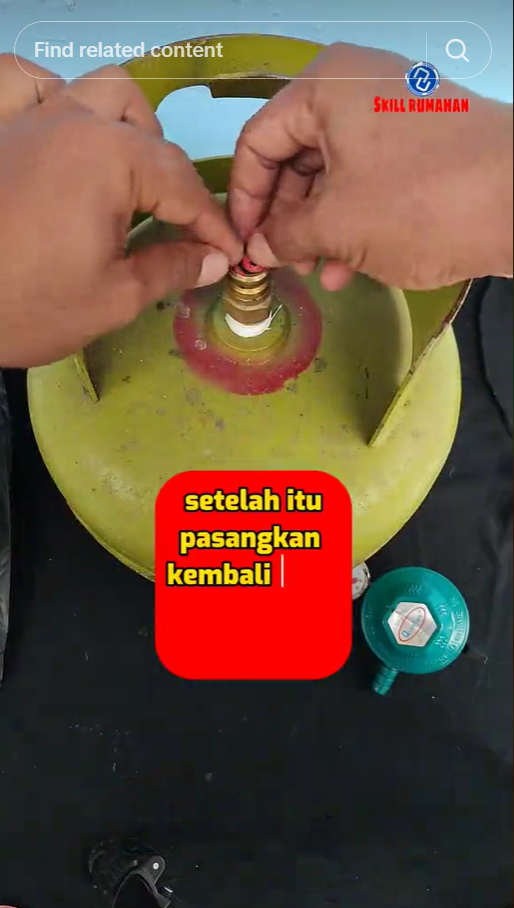foto: TikTok/@skill.rumahan
Brilio.net - LPG gas is one of the fuels that is often relied on for cooking. Apart from being easy to obtain, a number of types of stoves that are widely sold in Indonesia are also designed with this gas fuel. Therefore, the gas cylinder is an important item that must always be ensured that it is full so that the cooking process can run smoothly.
When the gas runs out, the gas cylinder will be replaced with a new one. However, in some cases, the gas cylinder sometimes leaks and can flow gas smoothly to the stove. This is usually characterized by a hissing sound coming out of the mouth of the gas cylinder.
To overcome this, some people usually replace the red rubber seal or even patch the seal with a rubber band. This is considered to be able to plug gas cylinder leaks, so that the flow is smoother.
Unfortunately, in some cases, this method tends to be less effective and cannot really overcome gas cylinder leaks. As a result, a number of people will use other tricks, as did TikTok user @skill.rumahan. Through one of the uploaded videos, he admitted that he only used one sewing tool.
Tricks for dealing with leaking and hissing gas cylinders.
Reported by BrilioFood on Monday (11/3), the sewing tool in question is thread. In the video, TikTok user @skill.rumahan uses thin black thread. However, you can use whatever sewing thread you have at home.

photo: TikTok/@skill.rumahan
How to use this thread?The first thing to do is remove the red seal first. After that, wrap the thread into the indentation of the middle of the red seal. Make sure the twist is tight and thick, okay?

photo: TikTok/@skill.rumahan
If the twist is tight, cut the thread. Then reattach the red seal to the mouth of the gas cylinder as before. After that, install the regulator as usual.

photo: TikTok/@skill.rumahan
Basically, the thread wrapped around the red seal will plug the gas cylinder leak. Therefore, gas will flow smoothly to the regulator and stove. This of course makes the stove's flame more stable.

photo: TikTok/@skill.rumahan
Having been watched more than 1 million times, this video about tricks for dealing with leaking and hissing gas cylinders immediately caught the attention of netizens. Who would have thought, many other TikTok users would be interested. Even in the comments column, quite a few claimed to have successfully implemented this trick.
"Wow, that's new... I'm used to using rubber bands... thanks sis.info," said TikTok @elfani14.
"Alhamdulillah, thank you for your knowledge, bro, " said TikTok @watifamily.
"I've really tried EMG," said TikTok @noer.
"Thanks a lot for the information, I often experience dizziness," said TikTok @maria.
"That's right bro, save me when I'm in the middle, always use bnang, I've been using bnang for a long time, the results are great," explained TikTok @ano5386.
Causes of gas cylinders hissing and how to overcome them.
A hissing gas cylinder can be a sign of a problem or gas leak that needs to be addressed immediately. Here are some common causes and how to deal with them:
1. High pressure.
Gas pressure that is too high can cause hissing. Make sure the gas regulator is set according to the needs of the gas device used.
2. Humidity.
Moisture around the tube or regulator can cause hissing. Make sure the environment around the gas cylinder is dry.
3. Dirt or dust.
Dirt or dust that gets into the regulator or gas line can cause hissing. Clean the regulator regularly.
4. Leaks.
Gas leaks can cause hissing. Check with soap or gas leak detection fluid and repair the leak immediately.
5. High level of gas usage.
High gas usage over a short period of time can cause hissing. Make sure the gas cylinder has sufficient capacity for the intended use.
6. Poor gas quality.
Gas that is not of good quality or does not meet standards can cause hissing. Use quality gas from a trusted source.
7. Use of the wrong regulator.
Using the wrong or damaged regulator can cause hissing. Make sure the regulator is used according to the instructions for use and is in good condition.
8. Unstable tube.
Unstable gas cylinders can cause hissing. Make sure the gas cylinder is placed in a safe and stable place.
9. Use of inappropriate accessories.
Use of inappropriate or unsuitable gas accessories or equipment can also cause hissing. Ensure that all gas equipment used complies with the manufacturer's standards and recommendations.
(brl/tin)